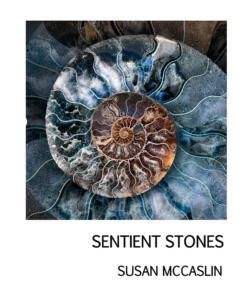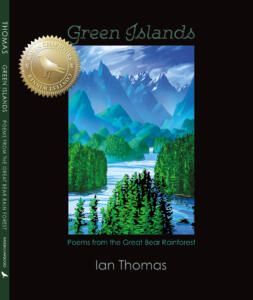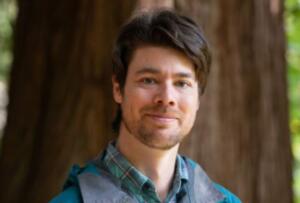1864 Three takes on spirituality and nature
Sentient Stones
by Susan McCaslin
Salt Spring Island, BC: Raven Chapbooks, 2023
$20.00 / 9781778160332
Wild Kin
By Marlene Grand Maître
Salt Spring Island, BC: Raven Chapbooks, 2023
$20.00 / 9781778160325
Green Islands: Poems from the Great Bear Rainforest
By Ian Thomas
Salt Spring Island, BC: Raven Chapbooks, 2023
$22.95 / 9781778160318
Reviewed by gillian harding-russell
*
 Though each poet has their own voice and vision, Susan McCaslin’s Sentient Stones, Marlene Grand Maître’s Wild Kin and Ian Thomas’ Green Islands: Poems from the Great Bear Rainforest make a lovely trio of chapbooks that partake of a spirituality in their approach to nature and environment.
Though each poet has their own voice and vision, Susan McCaslin’s Sentient Stones, Marlene Grand Maître’s Wild Kin and Ian Thomas’ Green Islands: Poems from the Great Bear Rainforest make a lovely trio of chapbooks that partake of a spirituality in their approach to nature and environment.
Whereas Green Islands follows a more commercial design with a shiny cover and is slightly longer (44 pages), Sentient Stones and Wild Kin are hand-stitched chapbooks threaded with blue-ribbon bindings (each 31 pages). All three are beautiful and a pleasure not only to read but also to hold and behold with their fine paper, cover art, and the artwork within their pages to complement the poems. I was enamoured by the handmade appearance of Sentient Stones and Wild Kin that reminds me of an era when books were not mass produced, but Green Islands, 2023 winner of the Raven Chapbook Award, is also a treasure.
All three have been published as limited editions.
 The icon that centres McCaslin’s vision and provides the cover art for Sentient Stones is an ammonite, a fossil that is curved like a ram’s horn and rather magnificently named after an Egyptian supreme god, Ammon Ra.
The icon that centres McCaslin’s vision and provides the cover art for Sentient Stones is an ammonite, a fossil that is curved like a ram’s horn and rather magnificently named after an Egyptian supreme god, Ammon Ra.
Even more pertinent, the ammonite is known for having survived in its fossil state since the mass extinctions that followed an asteroid. In the first poem “Mon Amie,” the speaker “cradles” an ammonite in prayer-like repose as she goes to sleep: “At first the rocked being is cold / but warms in the heat of my hands / cupped in prayer position around her form.”
Soon the speaker “drifts to sleep” and in that mini-death, the variously named “fossilized creature” and “spiraling foetus” comes to life as inward speech or inspiration inside dream: “In dying we live, in living die / Your time and mine, a single sentient circle.”

Here the coinage “sentient circle” that echoes the title informs a branching of themes that carries not only the sense of an inherent consciousness and spirituality in inert matter such as ammonites and stones but also embraces the idea of a circle of life and death to rebirth. In “Rocks & Stones Don’t Bluff,” planets–seen as “large rocks”–revolve around the sun that will eventually suck them into the black hole that the sun will become, but they may also be reborn as they “emerge / from the dark tunnel’s other side,” “kicking like newborns / warmed in their mother’s arms.”
A theme of inherent spirituality and wholeness in stones that makes them companions and brings comfort to the speaker runs through the sequence. Whereas in “Stone Thresholds,” the molecules that make up stone are seen as “both ands / clasping hands,” in “Stones in Bowls,” the speaker detects the “white fleck of a knowing eye” from a stone picked up decades ago on beach in Victoria that the speaker can hold “in the centre of [her] hand” to “banish [her] fears.”
From consciousness and companion comfort in rocks, the speaker questions whether they might speak to us outright, asking “What if the dumb stone isn’t dumb” and “Not a liar but a Pythagorean lyre”? Extended, this question might lead to a pantheistic vision, but–while not excluding this view– Fort Langley, BC’s McCaslin diverges and takes us along a different poet’s route:
Poets still seek the ley lines of the heart
following their inner lodestones’
magnetic leads
the lilt of their muses’
musical moods
Poets in tune with nature and its stones will intuit their fracture lines and magnetic fields when they follow “the lilt of their muses’ / musical moods.” Listen to the alluring sound architecture in the assembly of alliteration! Here, as quite frequently in Sentient Stones, the irregular line breaks and centre justification give the poem an exalted ode-like feel.
In the final poem, “Ammonite Song,” which provides closure as it echoes the first ammonite poem, “Mon Amie” (with its “spiraling foetus” become “My spiralling form” that “has no beginning and no ending), McCaslin gives speech to the ammonite, which offers wisdom in the form of paradox:
Love is unspeakable
but sometimes returns with bouquets of words
But far from proselytizing, McCaslin has the ammonite close with this wise reminder: “Who can compare wisdom sayings? / It’s not a competition.” With the opening and closing ammonite poems, this intricately woven sequence of poems forms an aesthetic circle even as it reflects a “sentient circle” of life-in-death and death-in-life whereby consciousness may be inherent in nature and indeed all around us throughout its phases.
 Like McCaslin’s ammonite featured on the cover design for Sentient Stones, the ghostly print of the “last Chinook salmon” provides the cover art for Grand Maître’s Wild Kin.
Like McCaslin’s ammonite featured on the cover design for Sentient Stones, the ghostly print of the “last Chinook salmon” provides the cover art for Grand Maître’s Wild Kin.
In “Vanishing Point” we learn about “blue gyotaku” or the Japanese method of print-making directly from the fish carcass, pressing fin and scales against rice paper that the speaker lays against her bedroom wall. In a phantasmagorical tableau, we witness the poet’s envisioned repercussions of this last animal death, while “cow and calf glide / through the bedroom / drawn by hunger.”
A similar fantastical projection appears in the beautifully constructed and intricately cadenced glosa poem “Slip the Knot” (that borrows lines from Louise Gluck’s poem “Messengers”). Here, the speaker presents a dream scene with wild horses that assumes allegorical suggestion as she approaches them—
Your heart wilds,
and you are horse. You rear and buck.
For a moment, you slip the knot
that makes us other.

In this mysterious poem, the horses’ seductive fascination in association with nature and its wildness is measured against some dread, as with death: “You walk towards the leader, / a white mare,” and in that beautiful encounter, the speaker experiences the terror of an unknown end.
Victoria, BC’s Grand Maître’s identification with nature and her reverence for its mystery and beauty is balanced by humour and playfulness in the title poem, “Wild Kin.” Although a darkness attends this fantasy world (with her “dead father”), in this dream poem he is marrying “a stone mermaid at Fleming Beach.” “On the shore, the only guests”:
a family of anxious hippos waiting
to meet relatives – a pod of orcas.
Will they recognize the river horses
as their closest living relative,
and more preposterously, will they “invite the hippos to take a dip.” This frivolous scene against an otherworld backdrop delights us with its sly social truths and comic turns. Indeed “orcas” are related to land animals, which reminds us that we may all be related on this planet whose animalia includes ourselves.
Grand Maître’s verses are elegant and chiseled, and her voice and vision carry the magic of a dark dream rendered the more engaging with flashes of beauty and humour. Between endings and extinctions, her deceased father and a vision of her own death as she embraces nature, Grand Maître’s ghostly vision draws us to the phantasmagorical and to what may only be partially known, or else unknowable.
 The cover art for Ian Thomas’ Green Islands–a stylized portrayal of the islands of B.C.’s west coast by Dale Hitchcox–provides the setting for the poems. Alongside this landscape art and past the chapbook’s inner leaf with wolf tracks on a black-night background is a map to orient the reader while reading the poems. Thomas’s intricate descriptions of nature that angle our seeing with hints of an underlying poet’s philosophy and his encounters with wildlife make this collection one to read carefully. And to savour. There are three encounters with wolves, and hence the inner leaf with wolf tracks on a black background is alluring. As so in nature, the wolf’s appearance is sudden:
The cover art for Ian Thomas’ Green Islands–a stylized portrayal of the islands of B.C.’s west coast by Dale Hitchcox–provides the setting for the poems. Alongside this landscape art and past the chapbook’s inner leaf with wolf tracks on a black-night background is a map to orient the reader while reading the poems. Thomas’s intricate descriptions of nature that angle our seeing with hints of an underlying poet’s philosophy and his encounters with wildlife make this collection one to read carefully. And to savour. There are three encounters with wolves, and hence the inner leaf with wolf tracks on a black background is alluring. As so in nature, the wolf’s appearance is sudden:
A little way up the wrack line, a long-legged wolf
is suddenly up
right in front of me.
Thomas’ description of the wolf is redolent of the scenery around him, as his “his fur is the colour of old kelp, / unevenly bleached” and his eyes “the colour of living kelp, / deep down roots” that in darkness are luminous and “bone-chilling jade.” In “Wolf at Grief Bay,” we see the wolf become a godlike icon in association with nature that has preceded us and will continue after us. “She had been walking for years, through valleys / no human has ever seen,” Thomas observes, which indicates the pristine nature of the island where the wolf treads. More chilling is the way in which the wolf regards this human intruding on her territory (significantly bracketed, as in an aside):
(looking at me she saw the face
of no one
I’ve ever known)

These verses suggest a mystery of origin and a sense that the wolf, having passed through the ages, might have seen earlier human faces or that it may even have powers to see beyond what humans can see and into the future. Also, in witnessing the human with lupine eyes, the wolf sees the speaker as he has never seen himself. When the speaker wakes up in the tent, he surveys the area and finds wolf tracks all around and his own disappeared. As Ted Hughes identifies with the fox in “The Thought Fox” to become one with the animal, here too the speaker in identification with the wolf seems to have become one.
As well as the wolf encounter, the speaker comes across otters, sandhill cranes, sandpipers, hermit thrushes and a grizzly bear (among other animals), and in all these poems Thomas’ passion may be felt. Although the imagery in a few of the poems strains to communicate the poet’s vision, the poems with animal encounters–and particularly the predators, the wolf and the grizzly–won my heart. Altogether the poet has a fine ear for cadence and a knotted music of the line with varying dramatic verse lengths so that, without exaggeration, he might be compared to his namesake Dylan Thomas in various respects. Here is a young new voice to watch.
*

A Saskatchewan poet, editor, and reviewer, gillian harding-russell lives on Treaty 4 territory. She has five poetry collections published, the most recent In Another Air (Radiant Press, 2018) and Uninterrupted (Ekstasis Editions, 2020). Both full-length poetry collections were shortlisted for Saskatchewan Book Awards. In 2016, a poem sequence Making Sense won first prize in Exile’s Gwendolyn MacEwen Chapbook Award. Also, a chapbook, Megrim was released by The Alfred Gustav Press in 2021.
*
The British Columbia Review
Interim Editors, 2023-24: Trevor Marc Hughes (non-fiction), Brett Josef Grubisic (fiction)
Publisher: Richard Mackie
Formerly The Ormsby Review, The British Columbia Review is an on-line book review and journal service for BC writers and readers. The Advisory Board now consists of Jean Barman, Wade Davis, Robin Fisher, Barry Gough, Hugh Johnston, Kathy Mezei, Patricia Roy, Maria Tippett, and Graeme Wynn. Provincial Government Patron (since September 2018): Creative BC. Honorary Patron: Yosef Wosk. Scholarly Patron: SFU Graduate Liberal Studies. The British Columbia Review was founded in 2016 by Richard Mackie and Alan Twigg.
“Only connect.” – E.M. Forster
3 comments on “1864 Three takes on spirituality and nature”